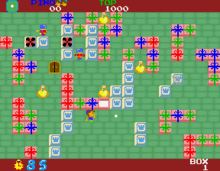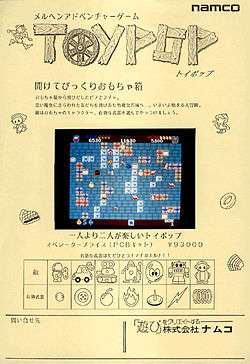Toy Pop
| Toy Pop | |
|---|---|
|
Arcade flyer | |
| Developer(s) | Namco |
| Publisher(s) | Namco |
| Composer(s) | Junko Ozawa |
| Platform(s) | Arcade, Wii (Virtual Console) |
| Release date(s) |
Arcade
Wii Virtual Console
|
| Genre(s) | Multi-directional shooter |
| Mode(s) | Up to 2 players simultaneously |
| Cabinet | Upright, cabaret, and cocktail |
| Arcade system | Namco Libble Rabble |
| CPU |
2x Motorola M6809 @ 1.536 MHz, 1x Motorola 68000 @ 6.144 MHz |
| Sound | 1x Namco WSG @ 1.536 MHz |
| Display | Horizontal orientation, raster, 288 x 224 resolution |
Toy Pop (トイポップ Toi Poppu) is a multi-directional shooter arcade game that was released by Namco in 1986. It runs on Namco Libble Rabble hardware, and was also the only game that the company released in their last 8-bit year that did not use a Yamaha YM2151 FM sound chip. The game was later rereleased as part of Namco Museum Vol. 1 for the original Sony PlayStation in 1995.
Gameplay

Toy Pop is a top-down multi-directional shooter that can be played both single-player or with two players simultaneously. The players venture through 44 floors (the game uses the toy-themed term "Box" as opposed to "Floor", to fit with the game's setting) collecting four gold hearts contained in jars on each floor in order to advance. Along the way, the players must open gift-wrapped containers concealing either weapons or score-increasing bonus items; these various weapons are used to defeat several different varieties of enemies (Heitai, Cars, Tanks, Domdoms, Trumps, Osaru, Robots and occasionally the evil wizard Mahou), with many typically vulnerable to only one type of weapon.
Plot
The game's backstory is that two dolls, Pino and Acha, have gone into the castle of the witch Majyo who has kidnapped their friends. The game's opening cutscene reads "PINO AND ACHA ARE GOING TO MAJYO'S CASTLE TO SAVE FRIEND" before gameplay begins. The game culminates with a battle against Majyo on the 44th floor, who can only be defeated by collecting the hearts that appear in random places around the room.
Release
To promote the game's 1986 release, Namco distributed yellow flyers to Japanese arcade establishments. These flyers presented information regarding the game, such as the rules of the game, pictures of the in-game enemies, and a single full-colored screenshot of Toy Pop's gameplay in the middle of the page. This flyer also included retail information such as the Toy Pop arcade machine's 93000-Yen price.
Stationery bearing Toy Pop artwork was also released. Two known designs that were featured include one that was a reproduction of the game's opening cutscene described in the above section, and the other being artwork of several of the game's characters grouped together.
Other Appearances
- Project X Zone 2 (2016 - 3DS):
External links
- Toy Pop at the Killer List of Videogames
